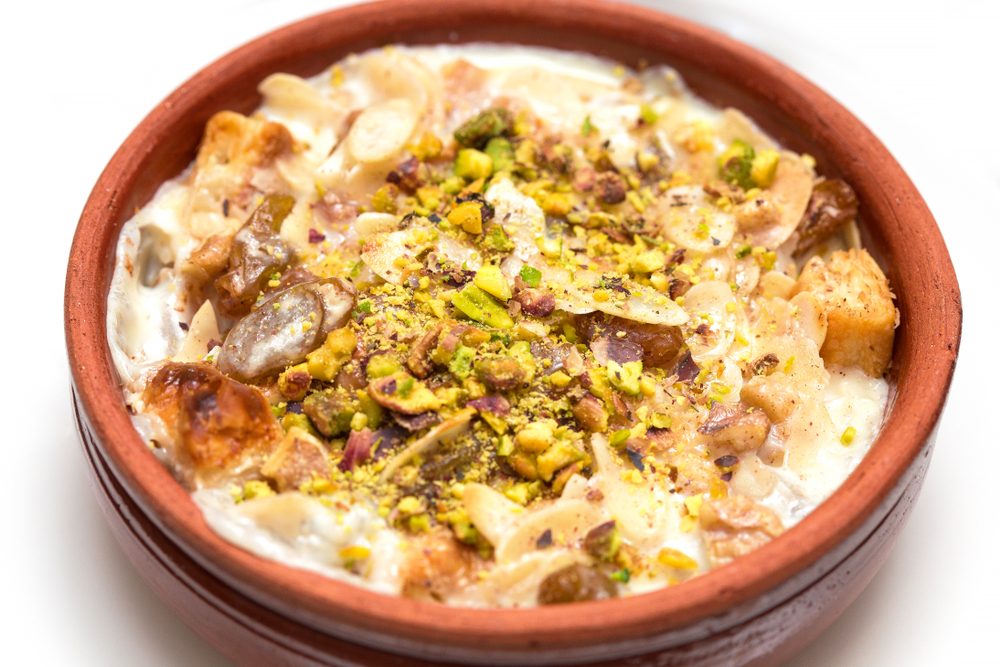The dessert has become an essential item found in almost every Arab restaurant’s menu.
For more than 700 years, Umm Ali has remained a hit in Arab kitchens across the region, especially to satisfy post-iftar sweet cravings during the holy month of Ramadan and to add a little sweet touch to feasts on Eid.
Its simplicity, intertwined with rich flavours and ingredients – sugar, nuts, pastry and dairy – catapulted it to becoming one of the most popular desserts that is favoured among many in the Arab region.
But surprisingly, behind Umm Ali’s sweetness stands a history that is filled with bitterness, and many will be shocked to know the dessert was actually born as result of murder, according to age-old tales.
The story goes back to the 1240’s, when Shajar Al Durr, the first Sultana in the Middle East, gained power following the death of her husband Assalih Ayyub, Egypt’s Ayyubid ruler.
At the time of the former Sultan’s death, Egypt was targeted by the Crusaders who were keen on seizing any and all opportunities to attack the country. In the absence of its ruler, Egypt would be seen as vulnerable, so to circumvent an attack, Shajar Al Durr hid the death of her husband and secretly buried him.
She told the people of Egypt at the time that the sultan was ill and unable to receive any visitors.
Read also: Dar Al Kutub: Rereading old chapters at the first library in the Gulf region
Despite this, it wasn’t long until the Crusaders found out about the death of Assalih Ayyub, triggering an almost immediate offensive into Egypt. The well-prepared Egyptian army at the time managed to trap the incoming Crusaders and killed Louis IX ‘s brother, Robert I of Artois.
As Egypt witnessed more and more victories over the Crusaders, Shajar Al Durr gained popularity among the Mamluks, one of the armies established during the Abbasid era. The Mamluks later assassinated Assalih’s son Turanshah in order to ensure that Shajar Al Durr remained in power. This was when she was declared the sultana.
Having a woman ruler angered the public, with many protesting against Shajar Al Durr.
Responding to the news, Abbasid Caliph Al-Mustassim Billah wrote a letter to Egypt saying: “Let us know if there is a lack of men in your country, for we can spare you some.”
Just 80 days after taking the throne, protests forced Shajar Al Durr to step down, making way for Izz al-Din Aybak who assumed her position as the first of the Mamluk sultans of Egypt.
Beginning of Umm Ali
However, Shajar Al Durr’s call to power did not end there. In fact, she went on to marry Izz al-Din Aybak to maintain a connection to the throne and from there was able to gain dominance over his life.
Soon enough, she was able to take charge of his political affairs and, more personally, stopped him from seeing his other wife, Umm Ali, later forcing him to divorce her.
After finding out about his plans to marry another woman, believed to be the daughter of Badr Addin Lo’alo’a, the Ayyubid Amir of Mosul, Shajr Al Durr decided to assassinate her husband.
Not long after, the Mamluks heard of the murder through testimonies by servants at the palace and had her arrested.
Meanwhile, Aybak’s first wife Umm Ali was steaming with anger over the murder of her husband and soon planned revenge on Shajar Al-Durr.
According to age-old tales, Umm Ali ordered her maids to kill Shajar Al-Durr by beating her to death, with some believing they threw wooden clogs at her until she eventually died.
Umm Ali was eager to celebrate the assassination and ordered her maids to find as many ingredients from the pantry to create a sweet dish – this later became the Umm Ali dessert we all know and love.
Follow Doha News on Twitter, Instagram, Facebook and Youtube
